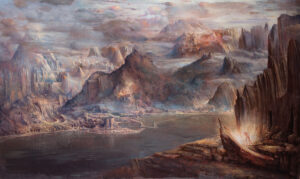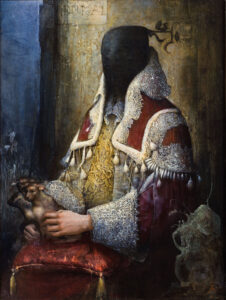Pearly concretions, gold dust and diamonds, oil, enamel, tempera and even insects encrust themselves on canvases and boards or on slices of petrified fossil wood: these are the precious supports of Agostino Arrivabene’s works, in which precious embroideries of colour clamber up and solidify into adamantine lorics.

Agostino Arrivabene, La grande opera, 2016, oil on linen, 250 x 150 cm, Agostino Arrivabene collection
And it is precisely to the belligerent sphere that it is appropriate to refer for this solo exhibition at Palazzo dei Diamanti, whose set-up, at the beginning, plunges us in medias res into the voluptuous and damned coils of the lustful in Erotomachia infera (2023), from whose jumble of naked bodies and winged devils, with their aged or skeletal faces, the couple of Paolo and Francesca, entwined in the eternal and luminous embrace of hell, detach itself. A retro-avant-garde struggle, that by Arrivabene, in defence of Ancient Painting, Myth and Beauty, which makes treasure – Thesauros it is the case to say – of the gifts inherited from the Great Masters, through an artistic practice that is a vehicle of precious rebirths, which in turn becomes a gift, finding in that Renaissance Ferrara the perfect place to be exhibited.

Agostino Arrivabene, Le mosche d’oro, 2014, oil, insects and gold dust on linen transported on board, 40,5 x 44,2 cm, private collection, courtesy Galleria Giovanni Bonelli, Milano
A clear tribute to this city is the coruscating landscape of The Great Work (2016), an alchemic blow-up inspired (as is the view of Asclepio’s Dream) by the naturalistic scenery visible between the columns supporting the throne of the Virgin of the Pala Portuense (1479-81) by Ercole de’ Roberti, the third representative in chronological order of the Ferrara Oficine discovered by Roberto Longhi, to whom the plaque affixed in Palazzo dei Diamanti is dedicated. A philosophy, that of Alchemy, which runs underground in all Arrivabene’s artworks, the result of a tribulation of matter, Magnum Opus reflecting the cathartic joy of silent and lacerating pain, turned into Painting. A process of sedimentation, workmanship and purification that, with regard to the place that hosts the exhibition, recalls precisely that undergone by humble Carbon to be transformed into the hardest and most precious of materials, which is diamond, transparent and penetrable only by light, just like a virgin.

Agostino Arrivabene, Ctesia Panax, 2012, oil on linen, 56 x 73 cm, Sergio Montoli collection, courtesy of the artist
This, in the exhibition, is found both in the Christian declination, in Fossil Virgin (2020, the most recent of the cycle on fossil wood, born in 2013-14 and represented in the exhibition by the first works), and in the pagan one of Persephone. She is portrayed now under a cloud of post-William Blake luminescences and dynamic directions, in Ea – exit (2016), now under the nuptial veil, in a gloomy and muddy dress, in the diptych of the Infernal Spouses (2013); or again holding a chimerical two-headed polychrome unicorn, an iconographic attribute of the illibate maidens since the Middle Ages, in Ctesia Panax (2012, also part of a diptych). A union, that one of virgin/unicorn, also present in the production of Gustave Moreau, another tutelary deity of Arrivabene’s poetics, together with Leonardo and Michelangelo, to whom Edward Burne Jones among the Pre-Raphaelites looked in particular.

Agostino Arrivabene, Lucifero, 1997, oil on linen, 50 x 60 cm, Agostino Arrivabene collection
Their attention to the Symbol, as well as to Dantean or Biblical themes, permeates the production by our artist, which also touches purely religious peaks in Sacred Blood (2016), Ecce Homo on a seventeenth-century panel, with bloody Dürerian curls concealing the face and gushing coral stigmata, combined (as in Angel of the Verse III) with the precisely coral branches of the cardiomorphic Reliquary for a Mirabilia (2017). This, together with Jewel Sculpture (2023), explicitly brings us back to the Wunderkammer collecting aesthetic, to which in fact the entire exhibition is imprinted in its omni-representational logic of the artist’s production. And the rich horror vacui of the chamber of wonders was already present in Athena conquered by Gorgon snakes sucking her nipples and in The Seven Days of Orpheus, both from 1996.

Agostino Arrivabene, Du mal II, 2011, oil on canvas, 55 x 73 cm, Michele Serini collection, courtesy of the artist
They are, on closer inspection, the most dated of the forty works in the exhibition – after The Guardian of Destinies (1985) – explosive with a chromatic/decorative jubilation in the tones of green, gold, magenta and cobalt, descriptive of the most minute details, be they floral, plumage or ornamental of the shield and lyre, gems of a list that, in the words of Umberto Eco in Vertigo of the list, “ideally ends in an etc.”. To the same stylistic imprint we can ascribe the almost coeval Lucifer (1997) which, like the Hades of Du mal II (2011) bearing a small Cerberus, has its face transfigured by a black void. A ‘modern Mona Lisa‘ in the words of Vittorio Sgarbi, curator of the exhibition, whose face is replaced by a black hole that sucks viewers in at the end of the elegant set-up on a red background. A black hole to represent the Prince of Light, a void in the middle of a florilegium crowned by a cauda pavonis composition, a voraginous oxymoron allowing the coincidentia oppositorum of Nigredo and Albedo, closing the alchemical circle with an antiphrastic seal.
Eliana Urbano Raimondi
Info:
Agostino Arrivabene. Thesauros
16/07/2023 – 1/10/2023
Palazzo dei Diamanti
Corso Ercole I d’Este 21, Ferrara

Graduated in Art Education, she began the communication activity of the visual arts with teaching at international exhibitions of artists including Regina José Galindo, Hermann Nitsch, Ai Weiwei. Active since 2018 as an independent curator, she is the author of monographs on artists, including “Life, art and miracles” by Manfredi Beninati (2018), as well as catalogs and texts for exhibitions in Italy and abroad. She is active in the field of dissemination through the organization and participation in conferences. She founded L’arca degli esposti, for which she is in charge of the artistic direction.






NO COMMENT